Dear creative friends,
Welcome to Issue No. 82 of the Studioworks Journal. October invites us deeper into the season, a time when patterns shift, days shorten, and the world around us takes on a more mysterious atmosphere.
This month, we turn our attention to Koloman Moser and the Vienna Secession, a movement that sought freedom in design, unity in the arts, and beauty in the balance of structure and spirit. Moser’s work reveals how pattern and printmaking can become more than decoration, they can carry meaning, mood, and even mystery.
In our creative lives, we often search for harmony between order and intuition, discipline and play. Pattern offers us that space: repeating forms that calm the mind, while symbolism invites depth and resonance. By combining the two, we create art that is both grounded and transcendent.
This month, let’s explore how design can guide us, how motifs can become meditations, and how the mystical threads woven through Moser’s work might inspire our own.
xo,

A recurring theme amongst great artists is the need to break the mould. It’s as if the fabric of creatives is woven with the knowledge that there is something more, that the status quo simply isn’t enough, that central to the imaginal space is freedom, flexibility, flow, and transformation. Sometimes, a core group of talented artists combine to slough off the confines of the acceptable, and the results reverberate across time. One such moment is the Vienna Secession.
As artists, we can garner much inspiration from the methods, the ideology, and the expansive vision of the Secessionists. Let’s dive deep into exploring the ethos of the brave souls who dared to defy the academic art traditions of their era and, in so doing, changed the face of their city, leaving an indelible impression on the art of their age and beyond.
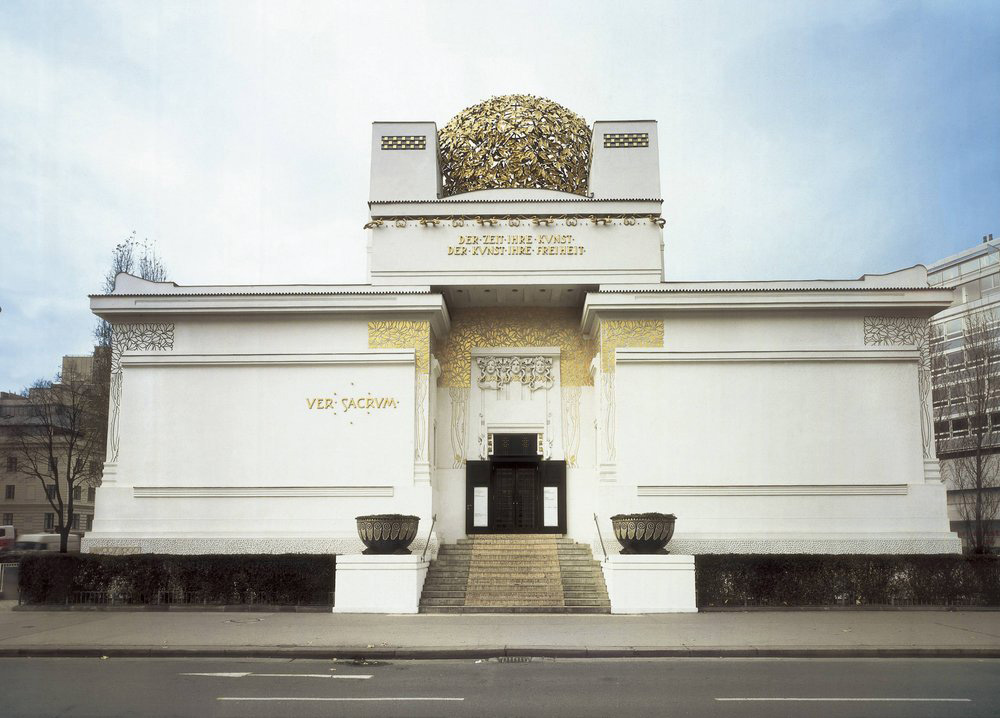
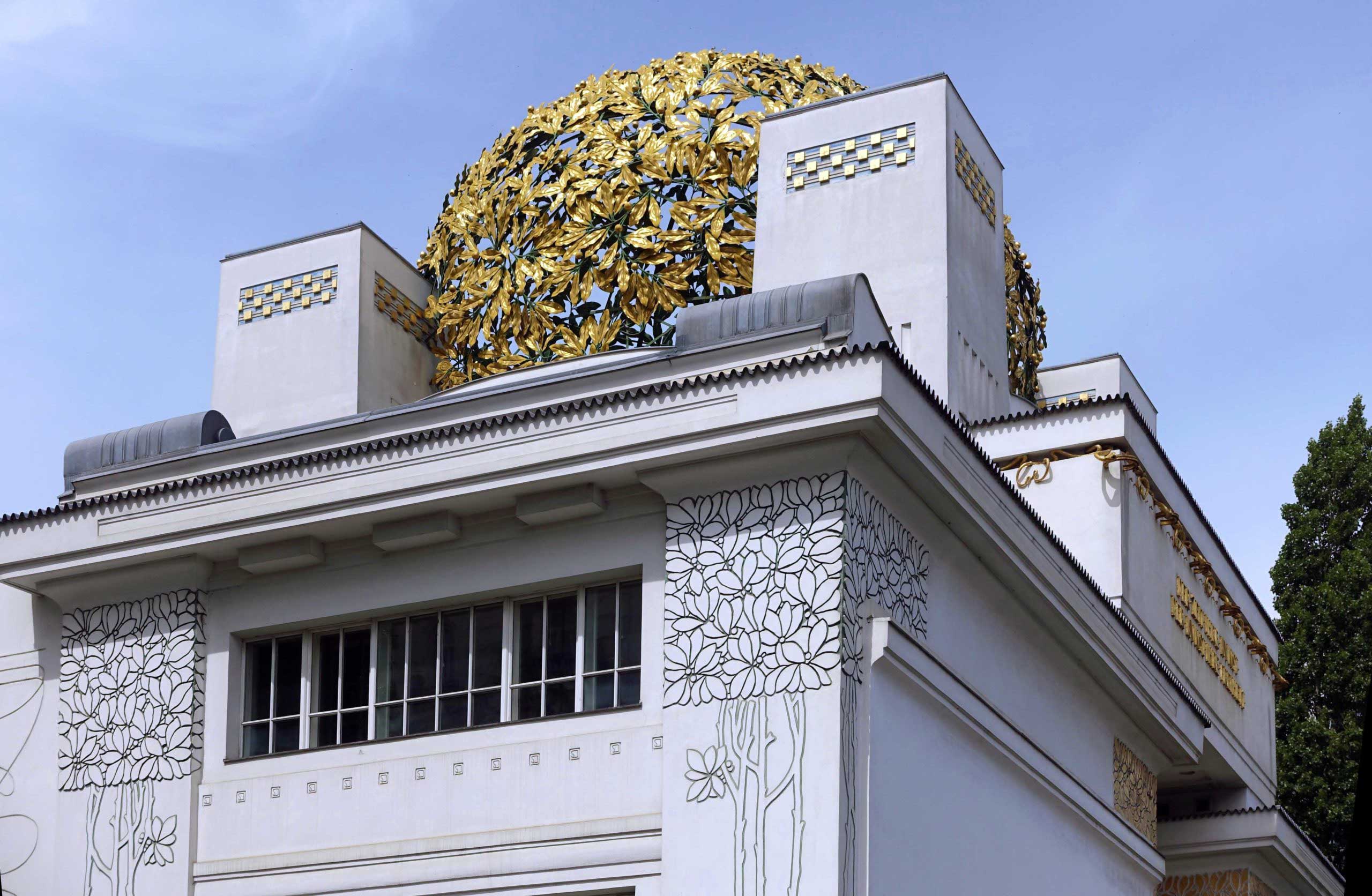
Vienna Secession Exhibition building completed in 1898
by Joseph Maria Olbrich
The 19th century ushered in monumental shifts in art movements worldwide. The French Impressionists made a resounding splash, Japonisme took the world by storm, and the British Arts and Crafts Movement reframed how we look at the ordinary, infusing beauty into the functional. However, as the century drew to a close, Austria’s capital city, Vienna, was still held in the clutches of classical art and conservative thinking. Artists were essentially limited to two sites to exhibit their work: The Akademie der bildenden Künste (the Academy of Fine Arts) and the private exhibiting society Künstlerhaus Genossenschaft.
The Küntslerhaus, designed in the style of an Italian Villa, was the primary location for exhibitions and decisions about which works were shown each year and which got the axe. It was tightly guarded by a presidency of conservative bureaucrats whose selections were safe, predictable, and classical, leaving many artists frustrated and uninspired.
Rather than losing heart, forward-thinking artists made use of cafes to gather, share ideas, and conspire to make a change. The two favorite gathering places, Café Zum Blauen Freihaus and Café Sperl, each spawned informal art societies. The former housed a group with a more naturalist bent, Hagendbund, and the latter the more stylized Siebener Club (Club of Seven). Despite his rising fame as a decorator for the Neo-Classical Ringstrasse buildings, Gustav Klimt began visiting the Siebener Club.
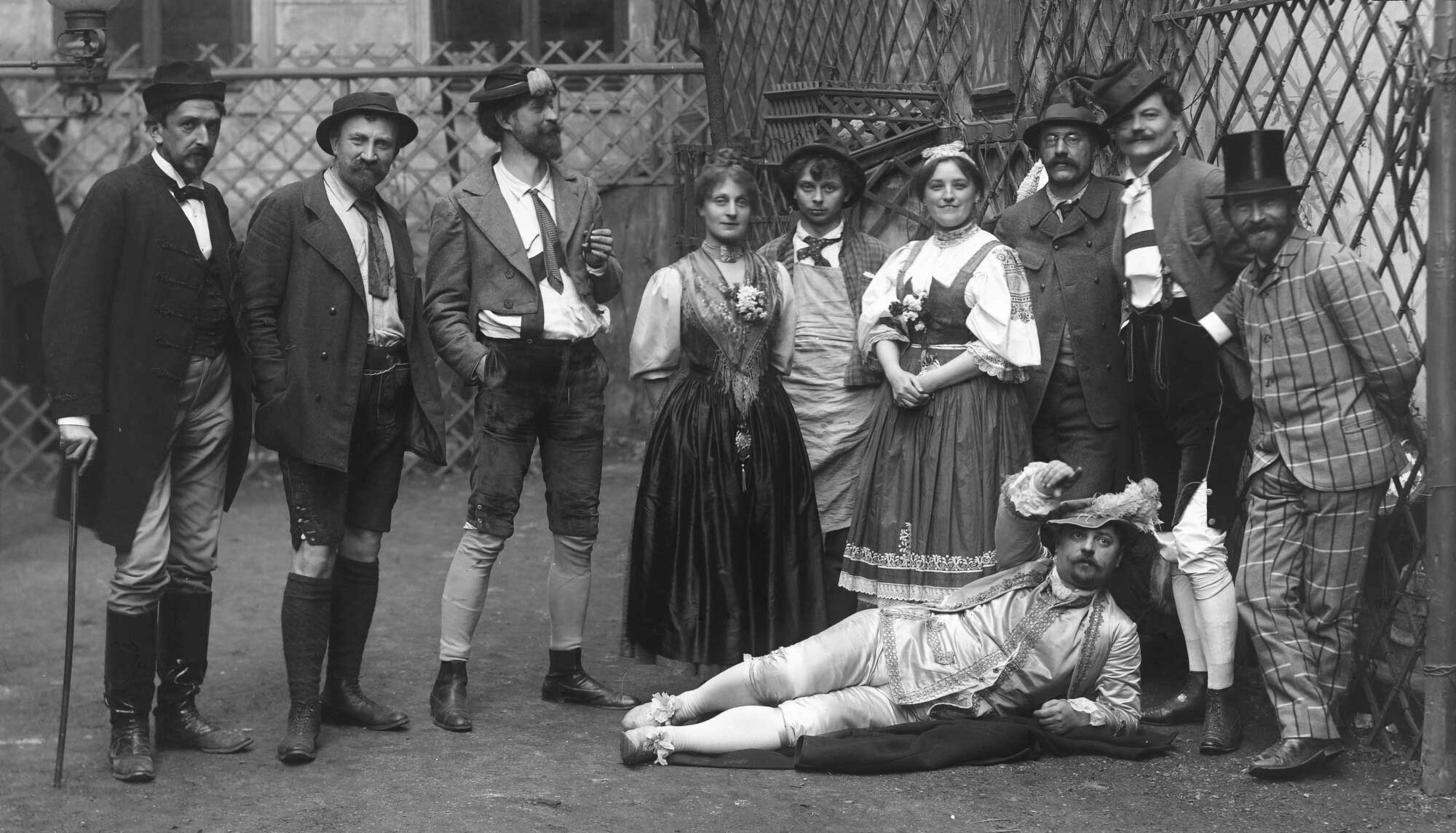
Photo of the Hagendbund group.
By the end of 1896, the artists had reached a tipping point. The re-election of staunch conservative Eugene Felix as the president of the Küntslerhaus led to formal complaints by many of the artist members whose works had previously been denied exhibition. With Klimt leading the charge, empowered by his artistic successes and acclaim, they formed a new society.
The spring of 1897 saw the break become official, with mass resignations from the Küntslerhaus sealing the deal. The Secession was comprised of 50 avant-garde artists, including Gustav Klimt, Josef Hoffmann, Koloman Moser, and Joseph Olbrich. The group consisted of painters, sculptors, architects, and graphic designers who drew inspiration from the Impressionists, Modernists, and Naturalists. They were also heavily influenced by the works of William Morris and the English Arts and Crafts Movement’s efforts to unify applied and fine arts, as well as the simplicity and purity of design garnered from Japanese art-woodblock prints in particular.
The result of all this creative cross-pollination was a uniquely Viennese pastiche of the best of the 19th century. The Secessionists unified their interdisciplinary approach under the theme of “the total work of art” or Gesamkunstwerk, which aimed to make each facet of life, from the high to the mundane, beautiful.
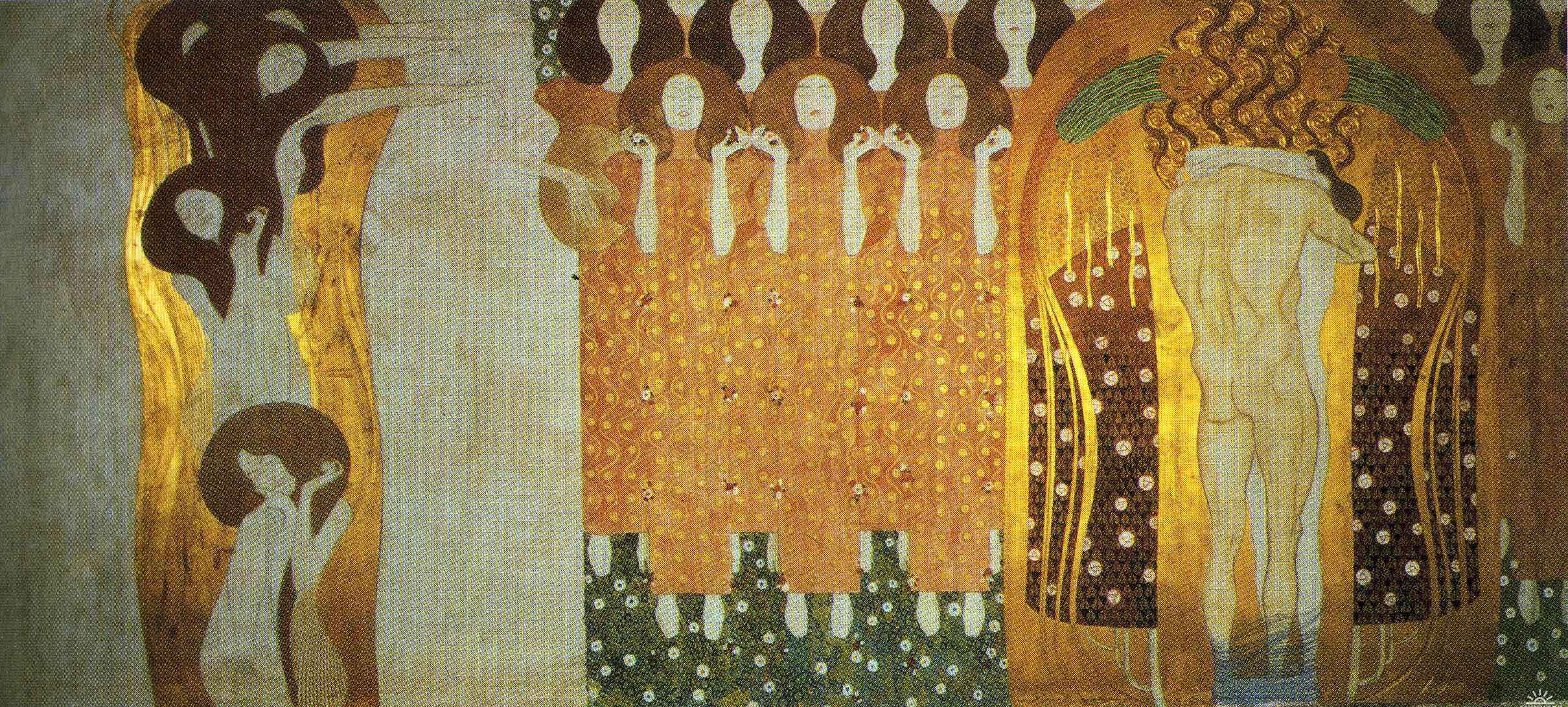
Part of the Beethoven Frieze by Klimt
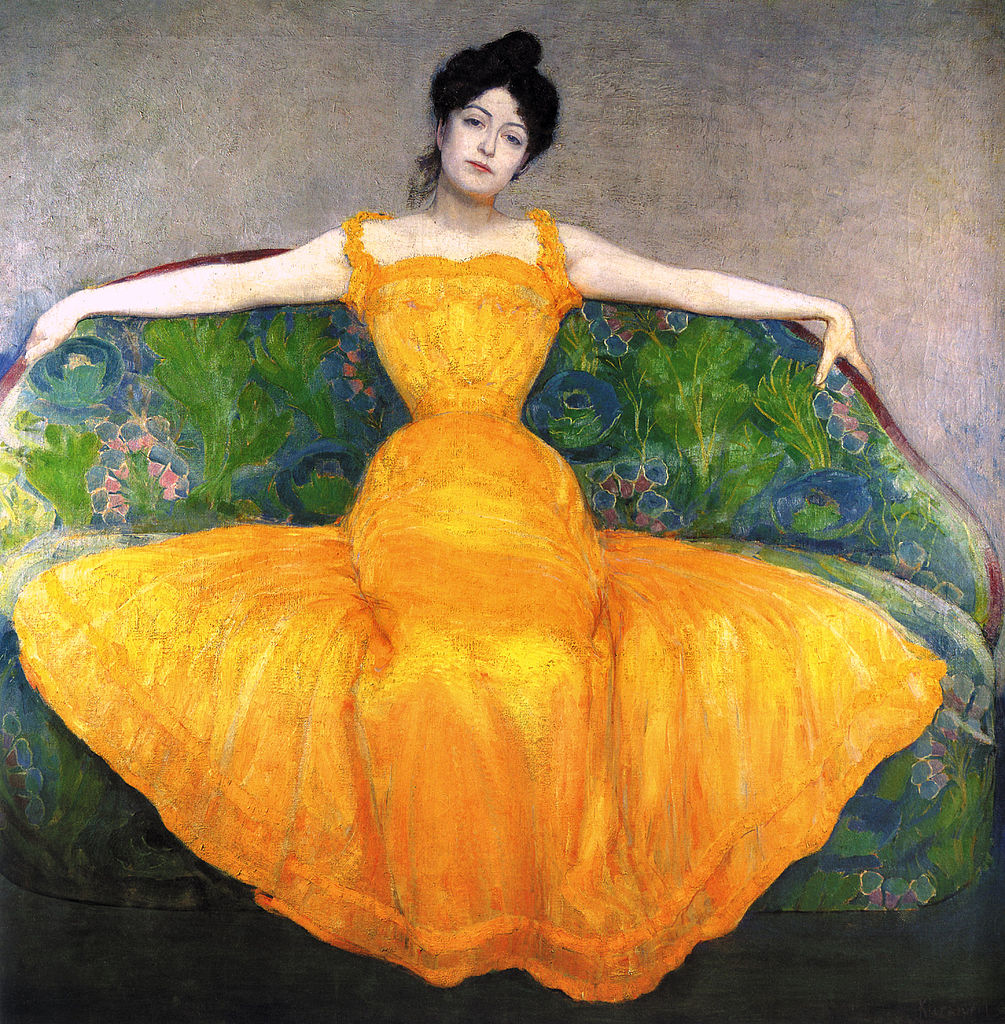
Woman in the Yellow Dress by Max Kurzweil
Art movements need a stage. After holding their first exhibition at the Horticultural Society, drawing 57,000 visitors, including Emperor Franz Josef, the Secessionists financed their own space. Architect Joseph Olbrich designed the Secession Hall in 1898, the first Austrian building dedicated to contemporary art.
Olbrich chose a minimalist design, shedding much of his Art Nouveau influences and leaning into simple, geometric forms that presaged the Bauhaus. The austere, windowless, white building is rich in symbology, with the owl and Medusa motifs at the entrance meant to evoke the goddess Athena envisioned in this context as the liberator and guardian of the arts. A frieze by Koloman Moser adorned one exterior wall, and the building was crowned by an elaborate gold cupola designed by Gustav Klimt.
The interior boasted movable walls and maximum flexibility for displaying all manner of art and sculpture simultaneously and in unique layouts. Also inside was the Beethoven Frieze by Klimt, which again leaned heavily on symbols, using characters to represent man’s search for happiness and salvation through overcoming obstacles and an exploration of good and evil. Capturing the mood of the moment and the core values of the Secession, above the entrance hall is written: “To every age its art-to every art its freedom.”
Many Secessionist works demonstrate lasting value and diverse appeal. Among these is Woman in the Yellow Dress by Max Kurzweil, which reveals a lovely fusion of influences from Symbolism and Impressionism, and itself later became an inspiration for the Expressionists. Another is the oft-reproduced poster for the Fifth Secession Exhibition by Koloman Moser, which is a pitch-perfect representation of his take on Jugendstil, the German version of Art Nouveau, that beautifully balances seamless aesthetics with functionality and wickedly ambivalent central images that cast an aura of mystery. Rounding out the manifold stylistic directions is a woodblock piece by Emil Orlik, Pilgrims Approaching Mount Fuji, which speaks to the flattened planes and uniform colors of Japanese masters while retaining a personalized, more Realist essence.
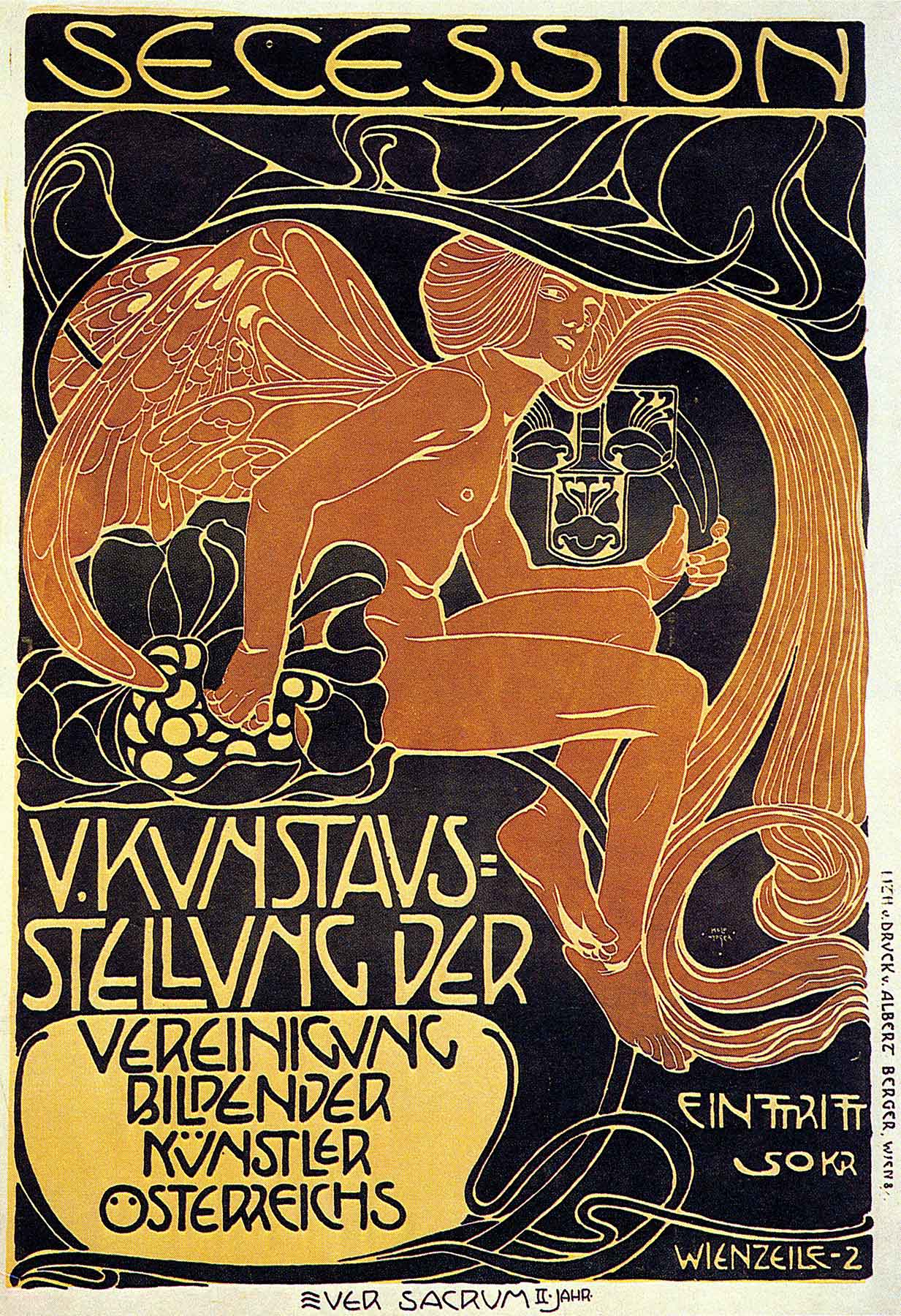
Fifth Secession Exhibition Poster by Koloman Moser
The makings of a poignant moment in history often entail great minds combining to create something unexpected. This occurrence spurs a revolution of sorts in which the old guard is overthrown to make way for something fresh and vital. The courage to leave the well-trodden road and break new ground is not easy to muster. However, in the case of the Vienna Secession, it changed the face of a nation, throwing open the doors to international collaborations and acclaim, and sending echoes through time that reverberate today.
As artists, we can gather much fruit from the many gilded branches of the Secessionists’ creative tree. They demonstrated, in a thoroughgoing way, that collaboration across genres, open-minded inclusion of disparate styles, and a willingness to take risks can yield something extraordinary. This liberation is something we can readily draw from, beginning with the question: What is the art of our age? And what happens when we freely create?
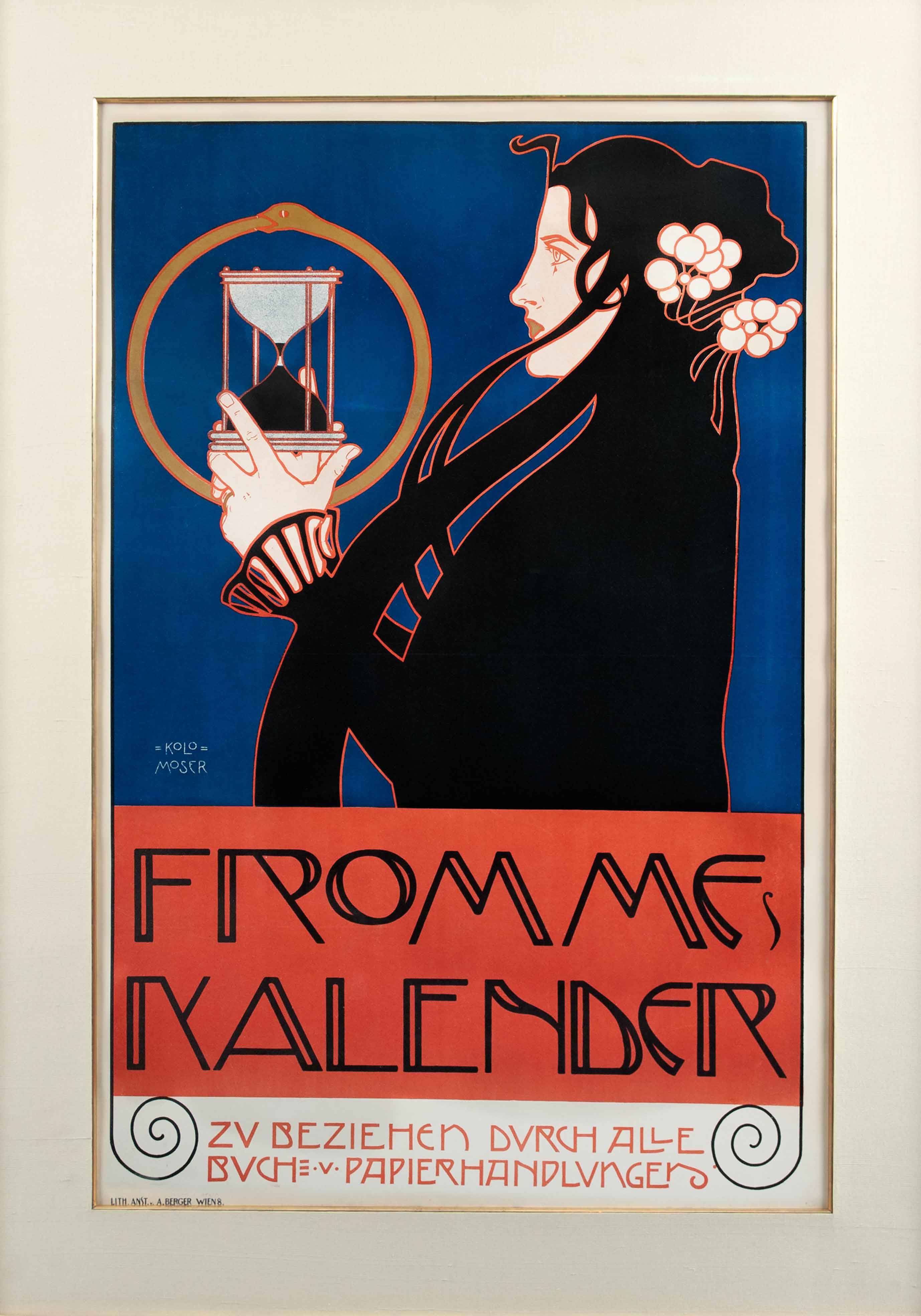
Fromme’s Kalender
by Moser - 1899
The Secessionists' remarkable array of influences and inclusion of wildly disparate media might leave the sense that the movement lacked cohesion. This impression couldn’t be further from the truth. Whether the work was a building, a painting, or a stained-glass window, the group drew from a pool of ideals centered upon creative freedom and the unification of all arts. The spirit of their vision revolved around the goals of inclusion, accessibility, innovation, functionality, modernity, and a challenge to commercialism.
On a structural level, the Secessionists leaned into symmetry, repetition, geometric shapes, floral-inspired decorative motifs, and images containing deep symbolism. They used color incisively, delighted in contrast, and liberally employed repeating patterns to emphasize the power of design. They preferred simple, clean lines to the excessively ornate, often abstracting and simplifying an image to create elegant motifs.
As artists, there are myriad ways we can apply these combined ideals and styles to our own creations, bringing innovation to our work. Let’s explore how the structure and spirit of Secessionist ideas can breathe life into our practice.
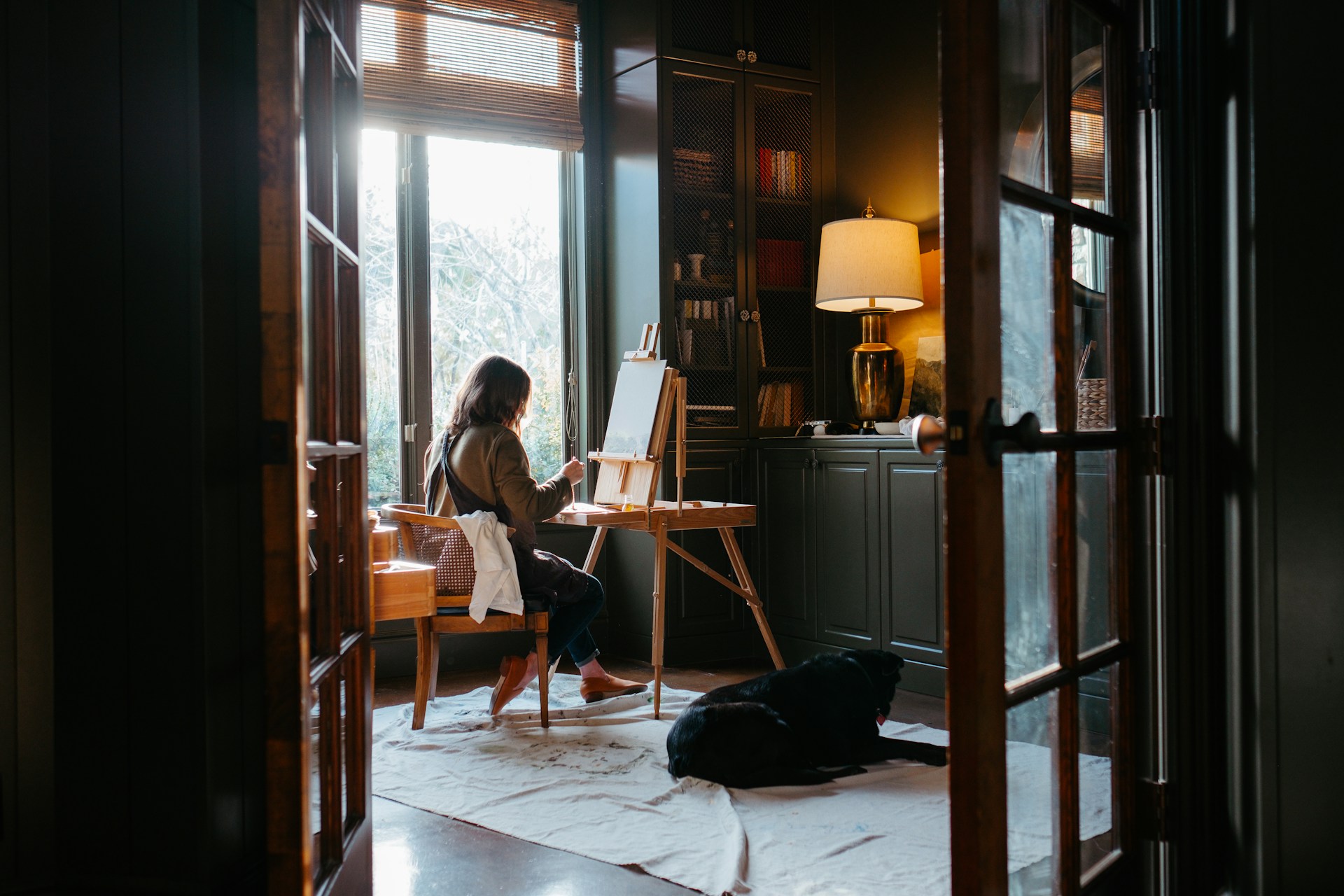
Let’s begin with tapping into the Secessionist spirit. Some practical ways to do this are to tear down some walls that might be hindering your creativity, being imaginative about how you combine media, and being more inclusive in your vision of what constitutes art.
To break barriers, you must first identify them. What ideas about making art are no longer serving you? How are external notions of what is beautiful and good limiting you? What ways can you shift your behaviors and thought patterns to find more liberation to create in new ways? Let your answers to these questions fill your well of inspiration.
To be innovative with the media you use means taking chances. Have you always wanted to sculpt, make ceramics, create installations from found objects, or make your paintings three-dimensional with impasto, collage, and layered construction? Try it! Allow your curiosity to lead you towards new combinations, no matter how wild or pedestrian, and trust your intuition.
To be more generous in how you define art, try seeing beauty in the mundane. If it’s not readily occurring, make it happen! For example, you could refinish an old wooden chair and paint it with a decorative pattern. Or, you might utilize a fabric medium or acrylic and paint a design on a t-shirt or a favorite old coat. The point is that anything from a cup to a broom to a curtain can be a piece of art that adds beauty and luster to your world.
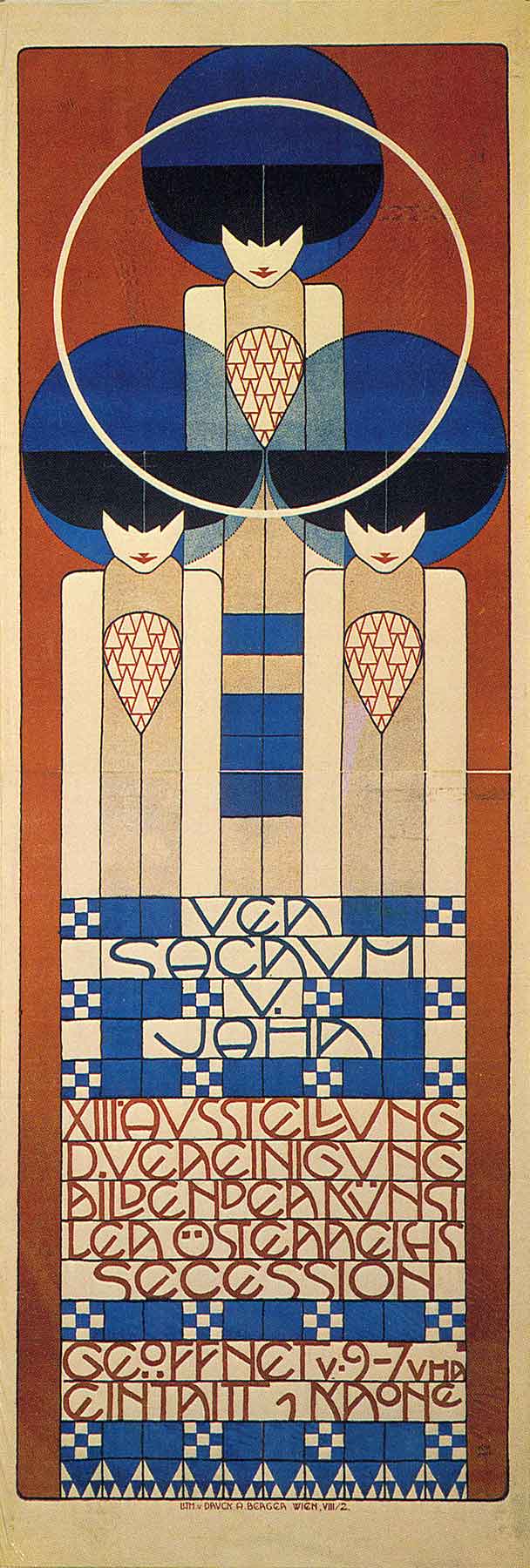
Poster for the 13th Vienna Secession exhibition
By Koloman Moser - 1902
Let’s continue by playing with the structural flavor of the Secessionists. We can implement their methodology in myriad ways, including employing symmetrical repeating patterns, carefully crafting and simplifying design elements, and utilizing symbolic imagery and characters.
A solid starting point for employing repeating patterns is to create a piece with a decorative border. To stay on theme, you could try a repetition of geometric shapes or floral-inspired motifs, leaning into a more minimalist execution rather than an ornate one.
Building upon the previous idea, you can pull out the main features of your design and see how they might be sculpted into something simpler that evokes an idea rather than representing it realistically. An excellent example of this is the “Glasgow Rose,” which stylizes a rose while simplifying it to a few lines.
Continuing the thread of stylization and abstraction, you can take those more graphic design elements and play with their symbolism. Think Gustav Klimt’s “Tree of Life” motif, which gorgeously simplifies a tree into a dense, flattened, swirling pattern that represents interconnection, the cycles of life, and spiritual transcendence.
The objective here is to recognize how virtually everything, from an apple with its connotations of temptation, knowledge, immortality, and divinity, to a star with its associations with guidance, dreams, aspirations, and destiny, contains symbolism. Looking for patterns and meaning, and finding a way to represent them in a simple, modernist way, captures both the structure and spirit of the secessionists.
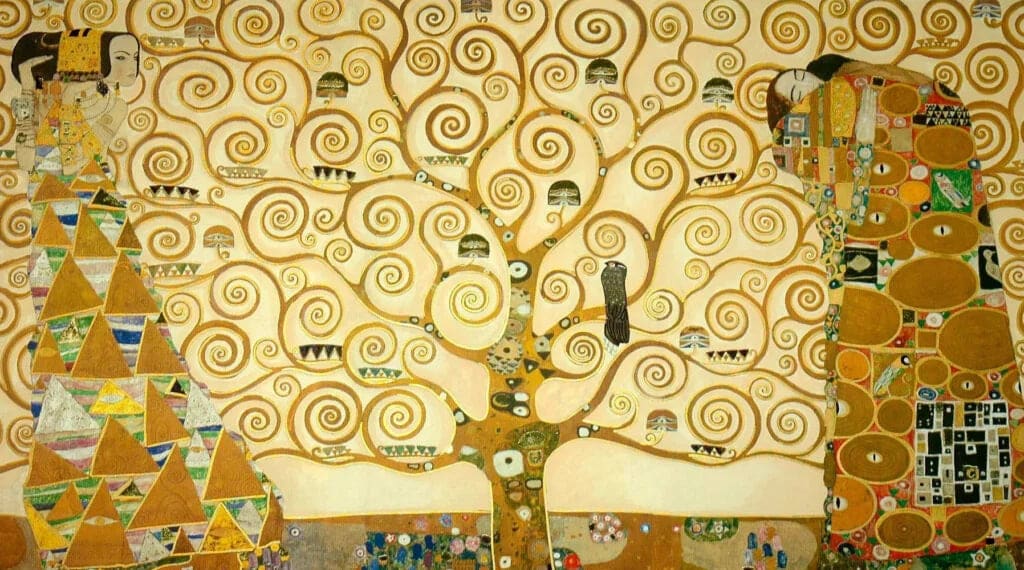
The Tree of Life, Stoclet Frieze
By Gustav Klimt 1905–1911
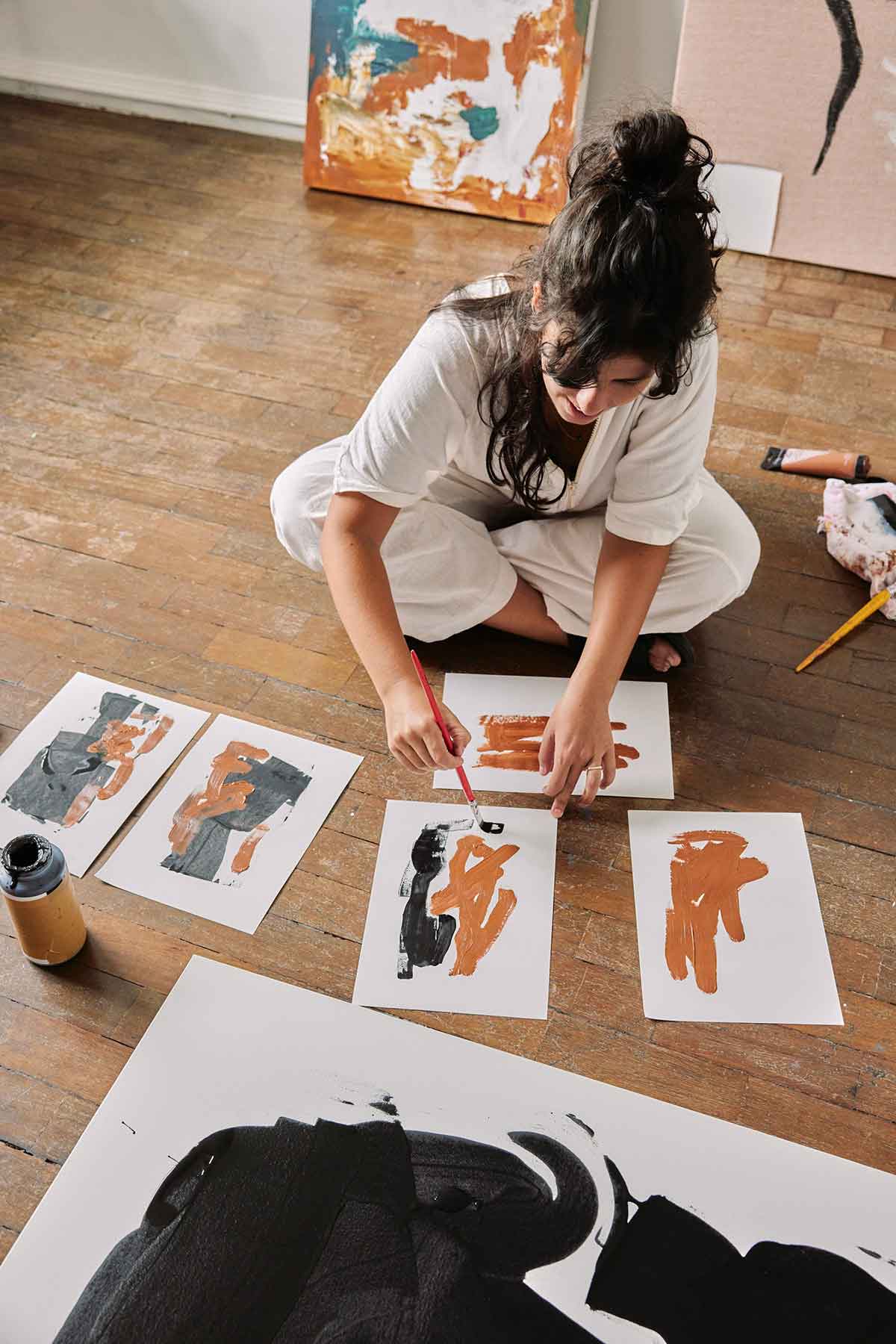
Secessionist ideas provide a treasure trove of artistic inspiration. Their creative courage, universal inclusivity, and innovative merging of styles across genres demonstrate the benefits of freedom for promoting artistic ingenuity. By tapping into the encompassing spirit of the Secessionist movement and grounding it in the structural design elements that they seamlessly employed, we vivify our work with an alluring balance of the celestial and the earthy.
Just as each half of a horizontally cut apple contains a five-pointed star, great art often contains symbols within symbols. When we incorporate this knowledge into our work, we just might create a thing of the earth with a piece of the heavens within.
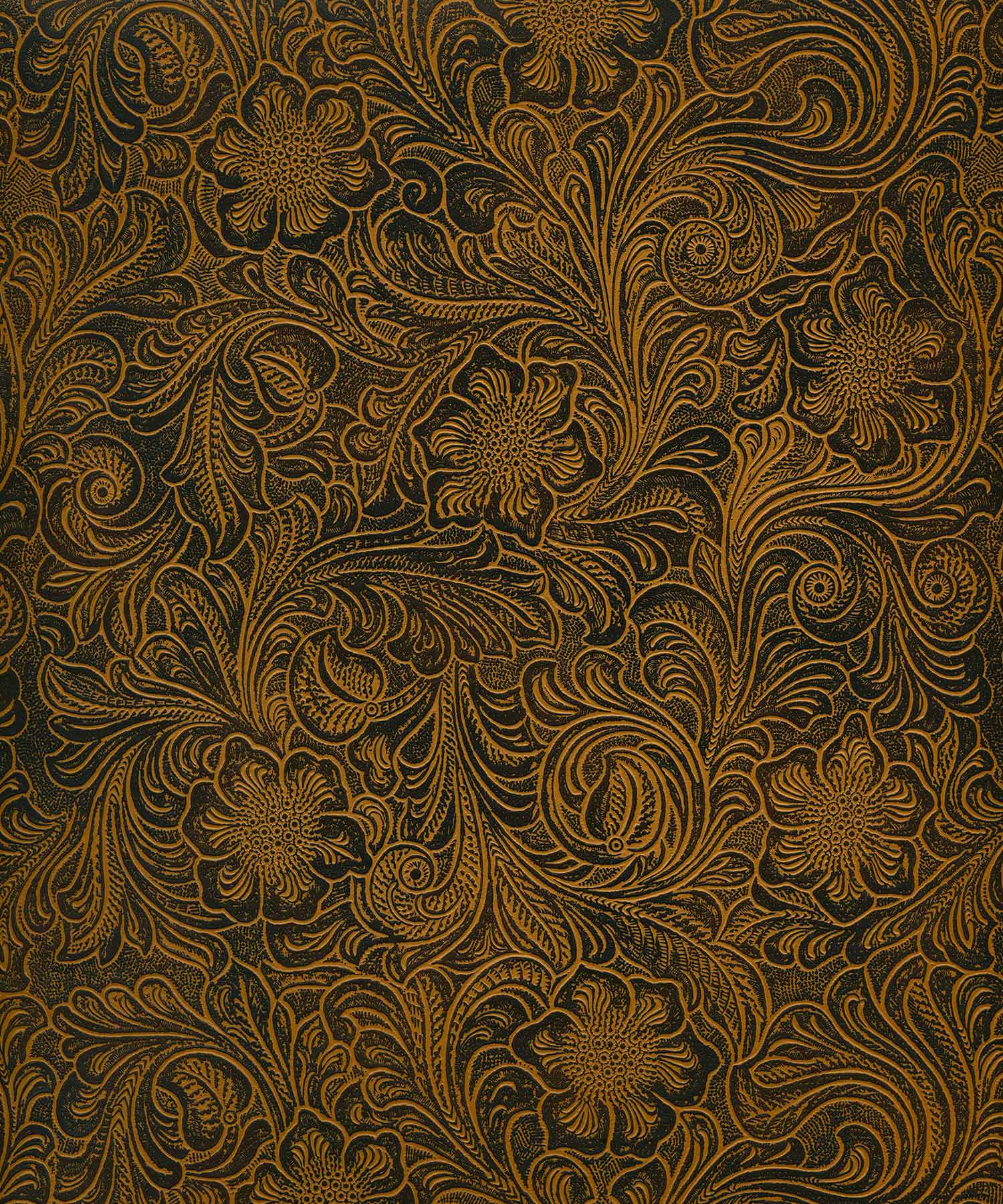
According to the Oxford English Dictionary, the word pattern is defined as:
A repeated decorative design.
Also: A model or guide for making something, or a regular sequence in which things happen.
Pattern is rhythm. Pattern is order. It is the echo of form, repeated until it becomes both familiar and meaningful. In art, patterns appear as motifs, lines, and shapes, but they also emerge in the way we work, the habits we carry, and the cycles of creation and rest.
As artists, pattern reminds us that repetition is not limitation. It is practice, meditation, and discovery. Each return to a mark, a color, or an idea reveals something new.
Working with pattern means finding beauty in recurrence. It asks us to repeat a line until it sings, to let shapes multiply until they form harmony, to notice how motifs connect and transform. Just as Koloman Moser turned design into something mystical through rhythm and repetition, we too can use pattern as a way to steady our hand and quiet our mind.
In embracing pattern, we allow our art to become both structure and flow, a woven surface where order and imagination meet.
Let’s tap into our creative intuition and do some self-reflective work inspired by our theme. Below you will see our month’s Oracle/Tarot card spread. But fear not, if you are not one drawn to using oracle or tarot cards, no worries, just use the accompanying reflective questions as writing prompts for your journals!
Here’s a three-card oracle card spread designed to tap into your creative intuition and our themes. This spread and its journaling prompts encourage reflection on the artist’s inner wisdom, the magic of inspiration, and the journey of trusting intuition in the creative process.
Before you begin, gather your deck and find a quiet space where you can focus. You may wish to set the tone by lighting a candle. Take a few slow breaths and let your mind settle.
With your question in heart : What patterns are shaping my creative life right now? Shuffle your deck slowly, paying attention to the rhythm of the cards in your hands. When you feel ready, cut the deck and draw three cards, laying them out in a row:
1. The Repeated Line
2. The Hidden Motif
3. The Design Unfolding
Spend a few moments with each card, noticing not only the imagery but also the way it feels as part of a sequence. Do certain colors, numbers, or symbols repeat? Is there a rhythm across the three cards?
Finally, step back and look at the spread as a whole. Like a pattern, meaning is often found not in a single piece but in how the parts connect.
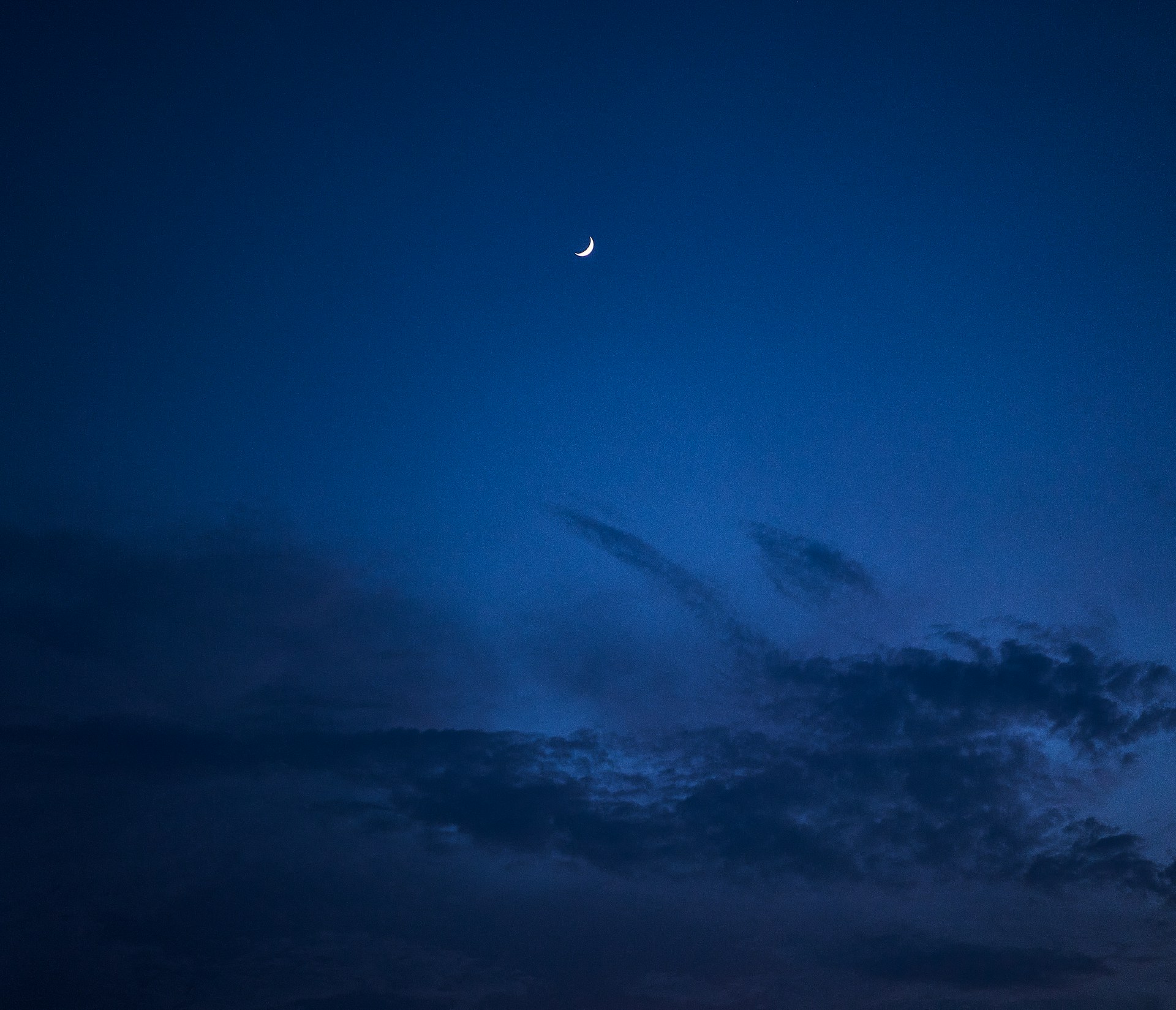
Treat yourself to this wonderful and powerful meditation from one of my favorite meditation creators - Rachel Hillary
Here’s a little more information from Rachel…
This practice is a guided journey into the magical sanctuary of the Third Eye. It's inspired by my own experiences and adventures in this beautiful sacred space. This is a simple, but powerful practice that is full of love and magic. We meditate beneath the stars, and allow the energy of a beautiful indigo sky to flow with our third eye.
I hope you enjoy, sending you love.
lots of love,
Rachel
Each month we will have a positive affirmation. I recommend you print out this affirmation and put it in your sketchbook or somewhere in your studio. Recite the affirmation out loud each time you show up to create. Saying words aloud is powerful and can begin to re-write some of our own limiting beliefs or calm our fears. Try it now…
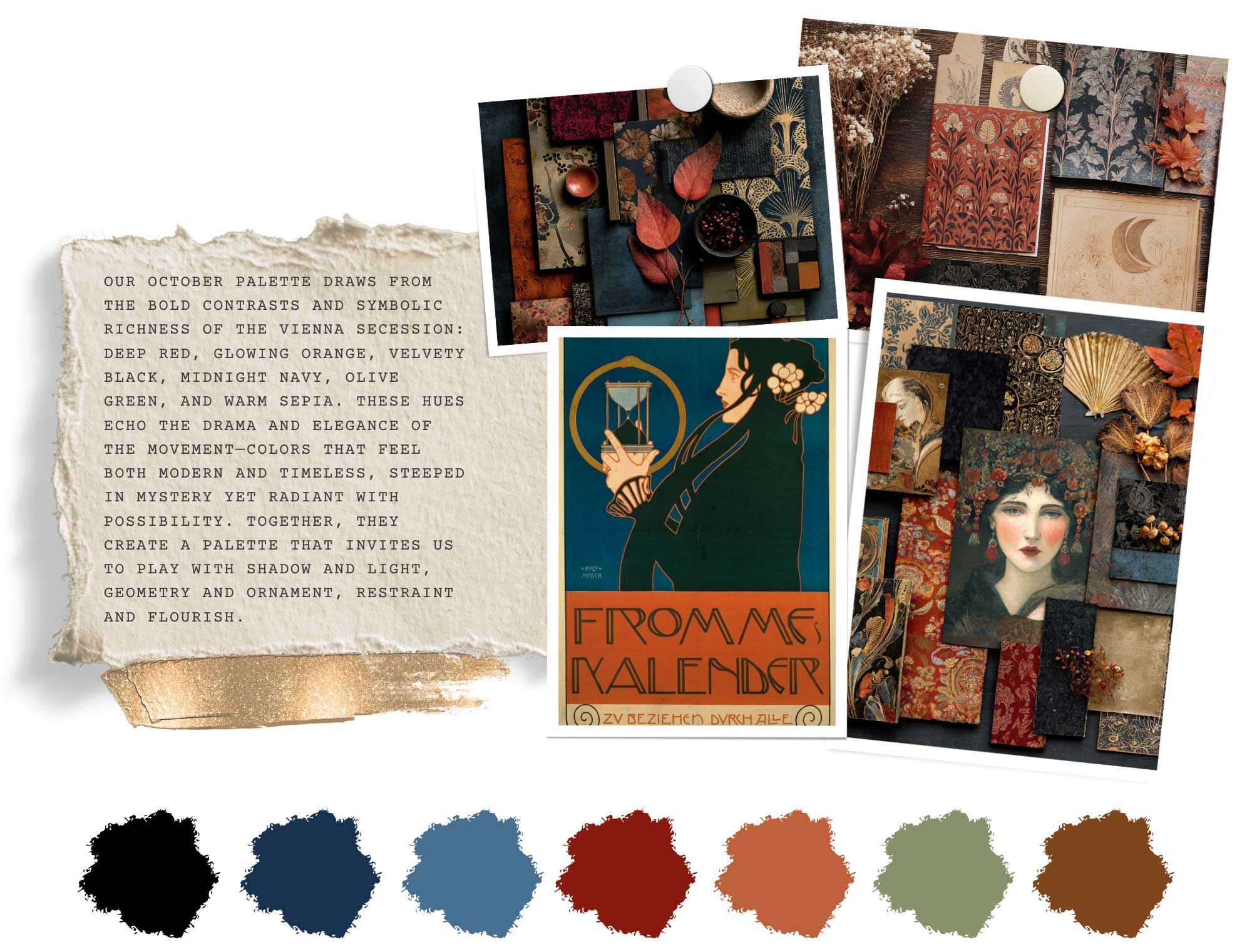
This month’s palette is shaped by the bold designs of Koloman Moser, a central figure of the Vienna Secession. His prints and patterns carry both discipline and mystery, where ornamental beauty meets symbolic depth. Strong contrasts and rich tones bring his motifs of flowers, figures, and mythic symbols to life.
We’re working with deep red, echoing the passion and drama in his work, and burnt orange, glowing like autumn leaves and fiery borders. Black grounds the palette, offering structure and clarity, while navy blue adds atmosphere and depth. Olive green ties us back to nature, seen in his stylized vines and leaves, while sepia recalls the aged warmth of printmaking and paper.
Together, these colors create a palette that is rich, graphic, and slightly mystical. They invite both strength and subtlety, order and imagination. They remind us that repetition and pattern can hold not just beauty, but meaning.
As you work with these tones, let Moser’s example guide you. Use them in strong contrasts, in repeating motifs, in designs where symbol and structure intertwine. Let them remind you that art can be both decorative and profound, a patterned surface that carries depth of spirit.
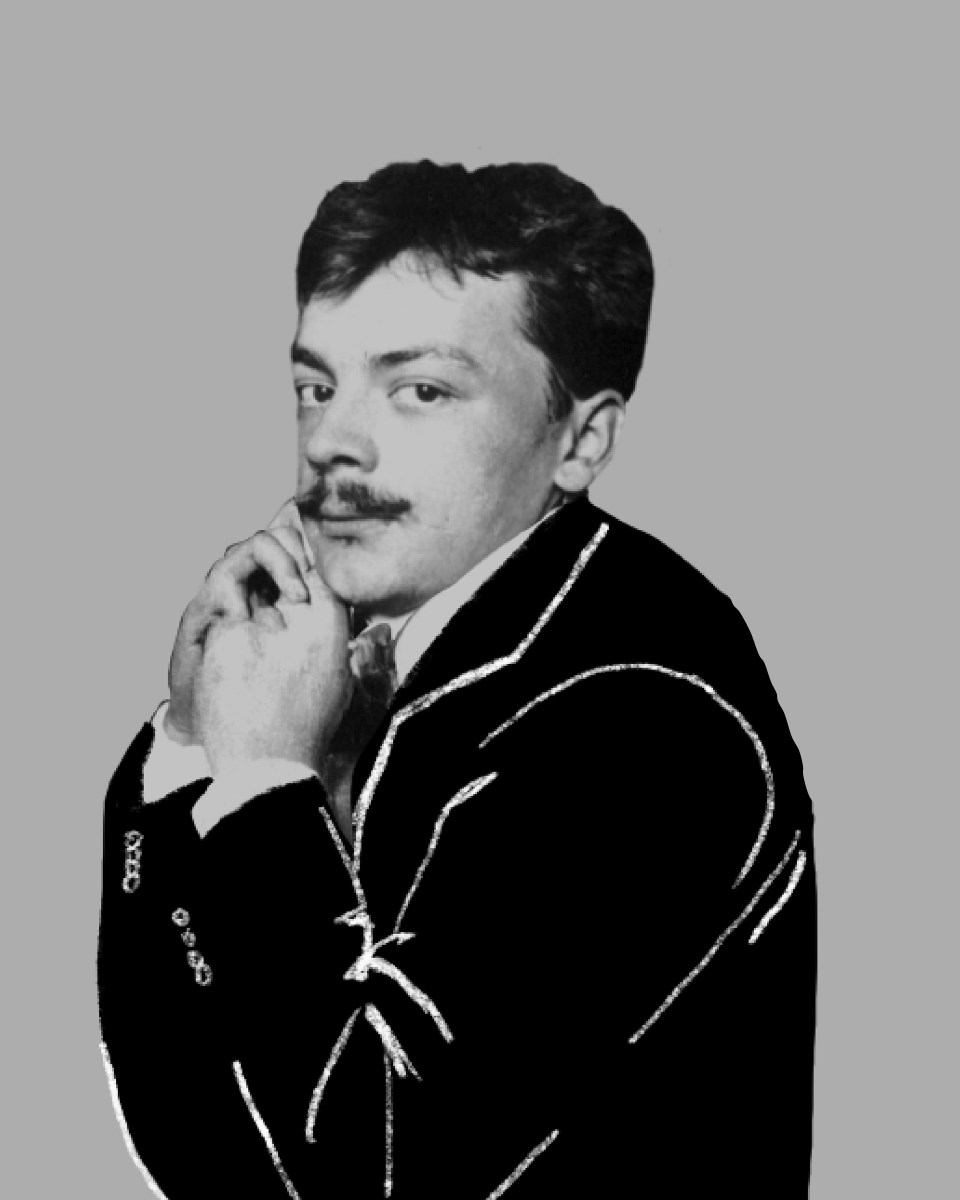
Koloman Moser (1868–1918) was one of the central figures of the Vienna Secession, a movement that transformed the cultural life of Austria at the turn of the 20th century. Born in Vienna, Moser studied at the Academy of Fine Arts and later at the School of Applied Arts, where his gift for design quickly became evident. He was not content to remain only a painter or illustrator, he was a true polymath, creating stained glass, textiles, furniture, posters, book designs, and decorative objects.
In 1897, together with Gustav Klimt and other like-minded artists, Moser helped found the Vienna Secession, a group that broke away from the conservative academic establishment. Their motto, “To every age its art, to art its freedom,” summed up their radical vision: that art must reflect the spirit of its own time, unbound by old rules.
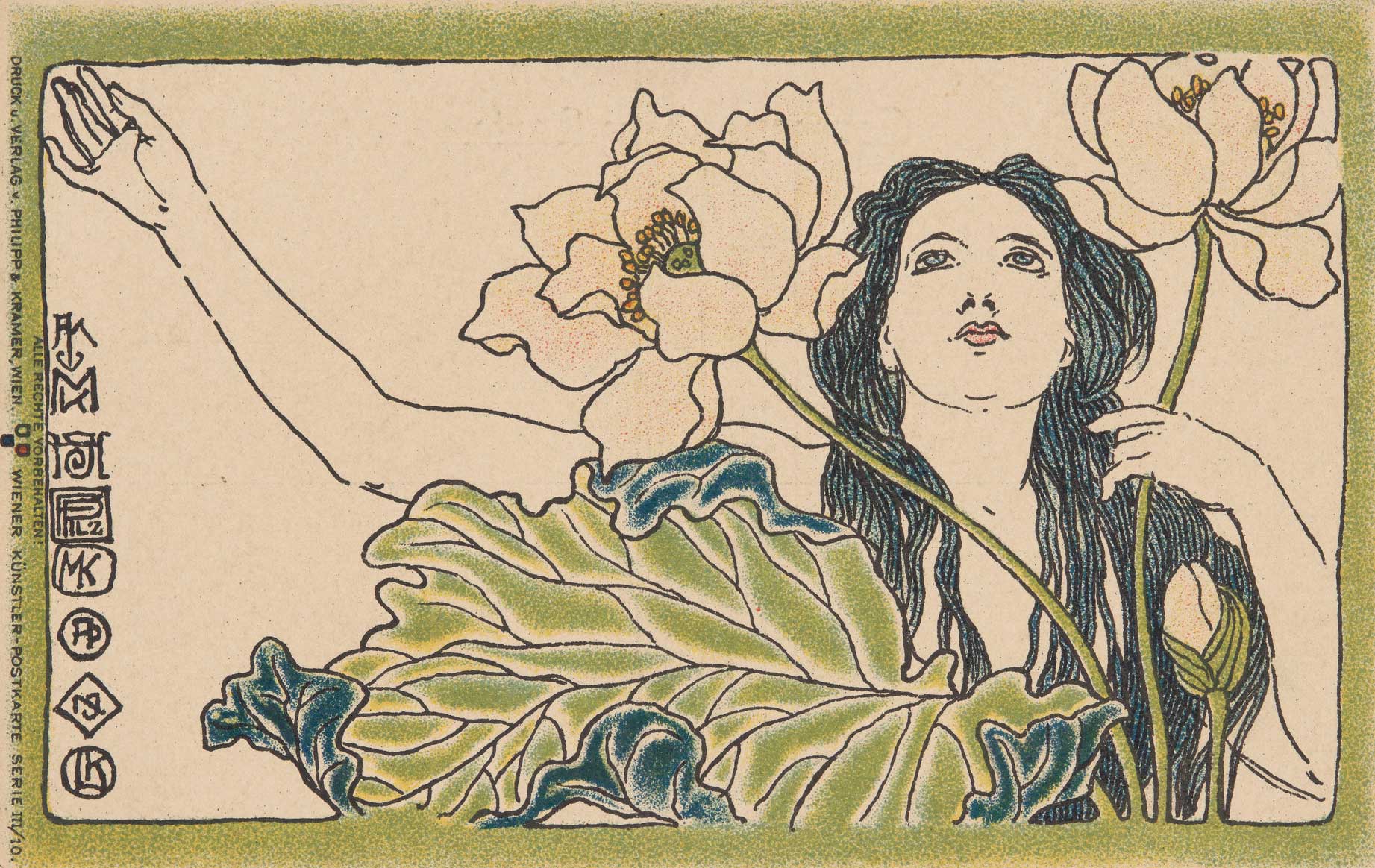
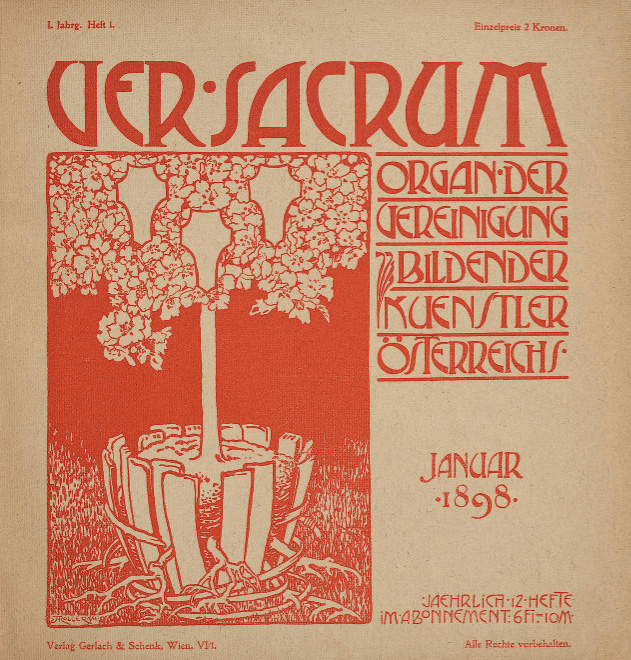
While Klimt often takes the spotlight, Moser was vital to shaping the Secession’s visual identity. He co-designed Ver Sacrum (“Sacred Spring”), the group’s official magazine, which became a platform for avant-garde art, poetry, and design. His prints, posters, and illustrations for the journal showed his mastery of pattern, line, and symbolic imagery.
He also played a key role in the creation of the Secession building itself, that iconic white temple crowned with a golden dome of laurel leaves. Moser designed stained glass windows, furniture, and interior elements for Secession exhibitions, embodying the group’s dream of the Gesamtkunstwerk : the “total work of art” where painting, architecture, and design merged into a unified whole.
What sets Moser apart is how he balanced structure and spirit. His works often featured strict geometry and repeated motifs, yet within these frameworks lived symbols of nature and mystery: owls, moons, flowers, and mythic figures. His art was decorative, yes, but never shallow. Pattern became a vessel for meaning.
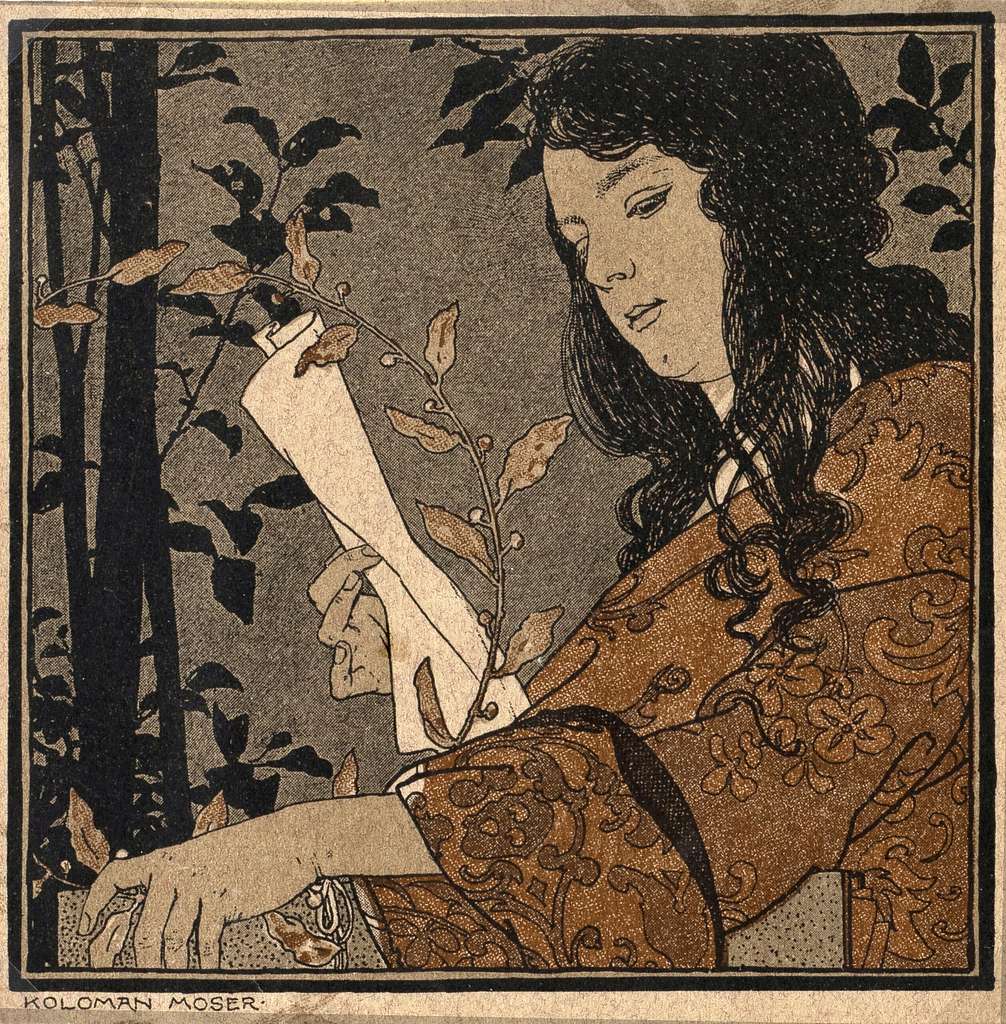
As practicing artists, Moser’s legacy invites us to think about the role of pattern and repetition in our own work. Pattern is not just decoration. It is rhythm, meditation, and resonance. Like a mantra in visual form, a repeated line or shape can hold emotion, memory, or symbolic power.
Moser also reminds us that art need not be confined to one medium. He moved fluidly from canvas to textile, from book design to stained glass. His example encourages us to ask: where else can my creativity flow? What happens if I allow my art to cross boundaries, from sketchbook to fabric, from print to object?
Perhaps most importantly, Moser’s role in the Secession shows the power of community. He and his peers built something larger than themselves, a movement where art was not just an object, but a way of shaping culture. For us, this is a reminder that our creative lives are not lived in isolation. Sharing, collaborating, and participating in larger conversations can amplify the meaning of our individual work.
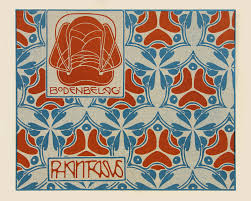
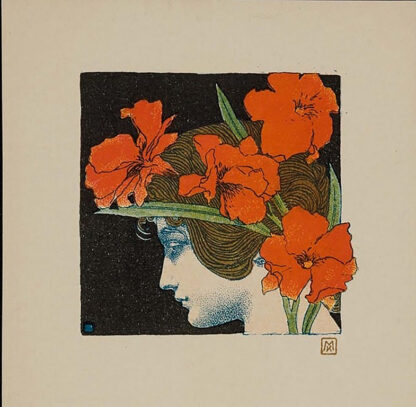
Moser’s life ended too early. He died in 1918, at the age of 50 from throat cancer, the same year as Klimt, Schiele, and architect Otto Wagner, as the Spanish flu ravaged Europe. Yet his legacy lives on in the lasting imprint of the Secession and in the many objects, prints, and designs that continue to inspire artists and designers worldwide.
His art reminds us that pattern is not mere surface it is structure, symbol, and soul. And as we step into this October issue, Moser offers us the invitation to see design not as limitation, but as liberation: a way to harmonize order and imagination, structure and spirit.
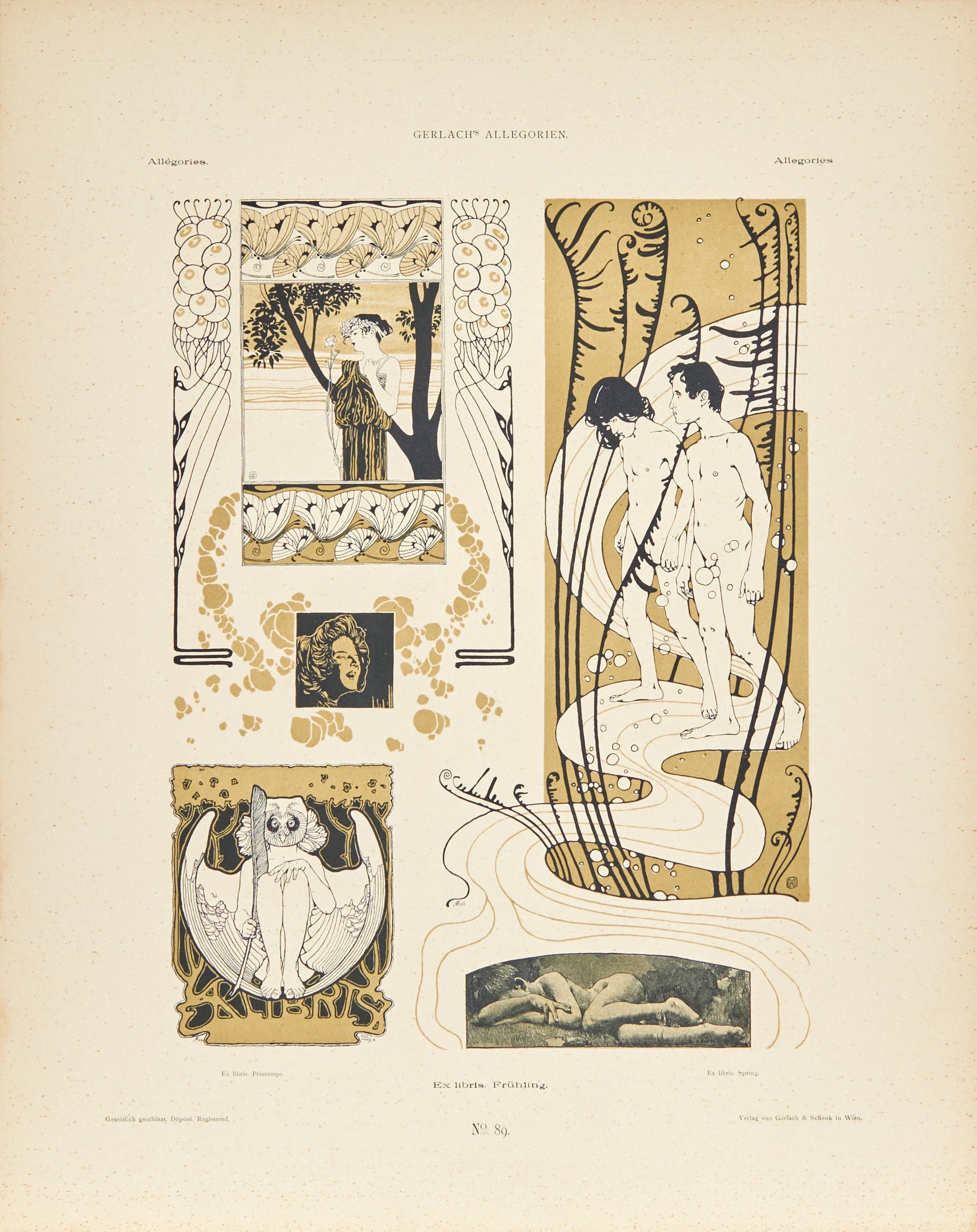
On a fresh page, choose a simple shape, a circle, leaf, a star or other pattern. Draw, stamp or stencil it once, then repeat it across the page in rows, arcs, or radiating patterns.
Experiment with color as you go: try deep red beside navy, or burnt orange against black. Let some motifs overlap, fade, or break apart.
Once the page feels full, step back and look for rhythm.
Reflect: What does repetition do to your symbol? Does it gain power, beauty, or mystery through being multiplied?
Here’s a Pinterest board to further inspire you with pattern play...
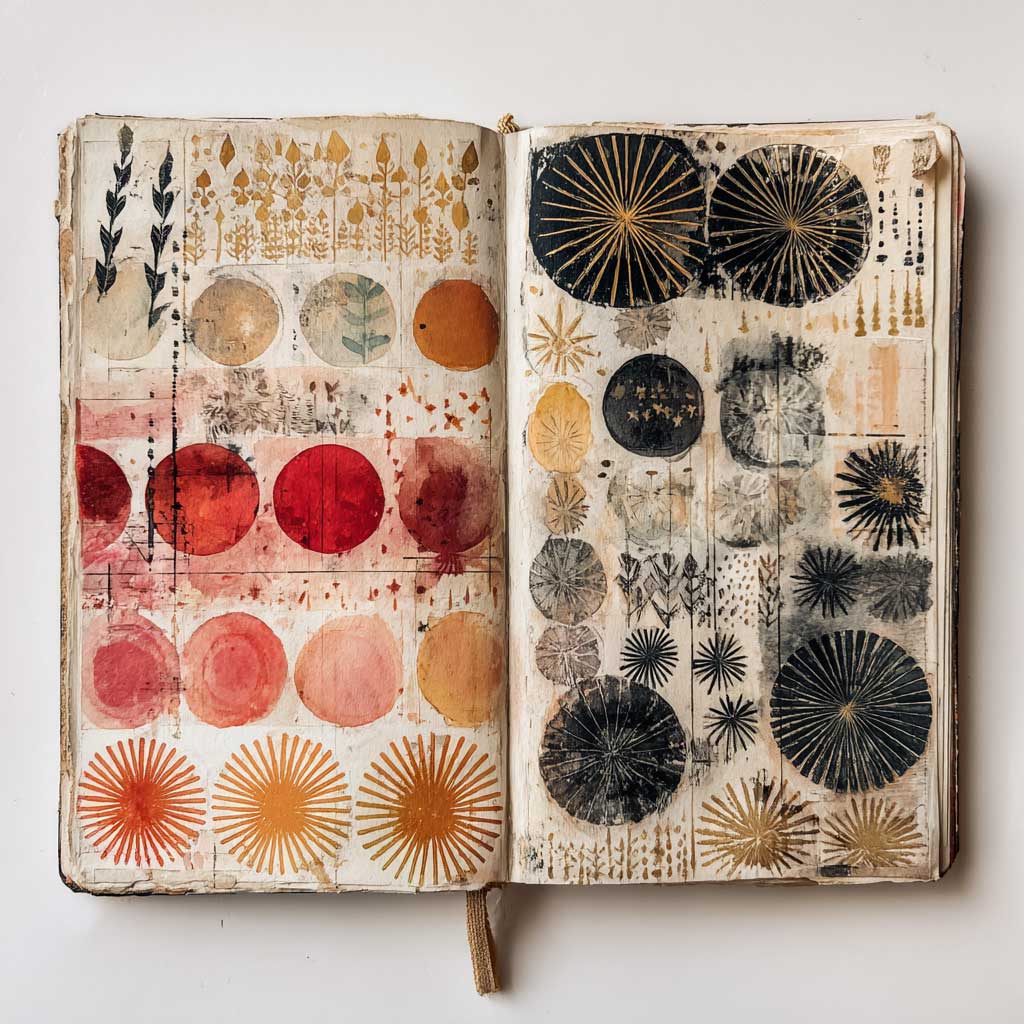
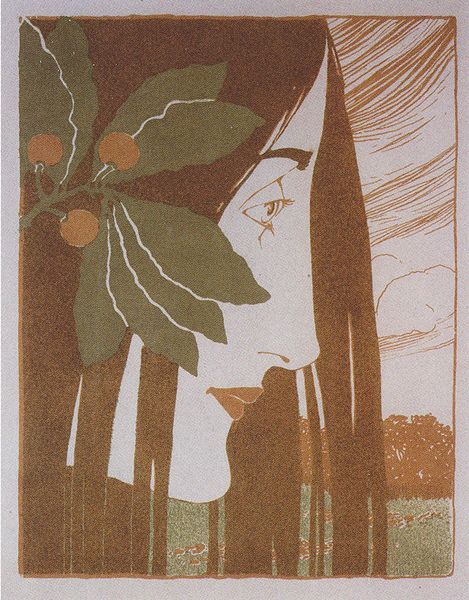
Choose one of Koloman Moser’s works that speaks to you, it might be a poster, textile design, or illustration. Print it or pull it up on your screen.
In your sketchbook, recreate it as closely as you can. Pay attention to his use of shape, line, and color. How does he balance bold geometry with delicate detail? How does repetition create atmosphere?
You don’t have to finish every element, focus on what interests you most. Even a partial study will reveal a lot about his technique and choices.
Reflect: What did you notice about Moser’s process as you copied his work? Did any surprises surface, shapes you hadn’t noticed, colors you hadn’t considered?
You can check out more of Moser’s work on our Pinterest board...
Draw a large rectangle in the center of your page, creating a “poster” space. Inside, place a single symbolic image, an owl, a moon, or a flower. Keep it simple.
Now, surround the image with decorative borders. Use repeating lines, arcs, dots, or geometric shapes in olive green, sepia, and burnt orange. Think of how Moser turned even simple motifs into elaborate frames.
Allow contrast: dark outlines against lighter fills, or bold black against navy.
Reflect: How does framing change the meaning of your symbol? Does it feel more powerful, elevated, or mysterious when given structure?
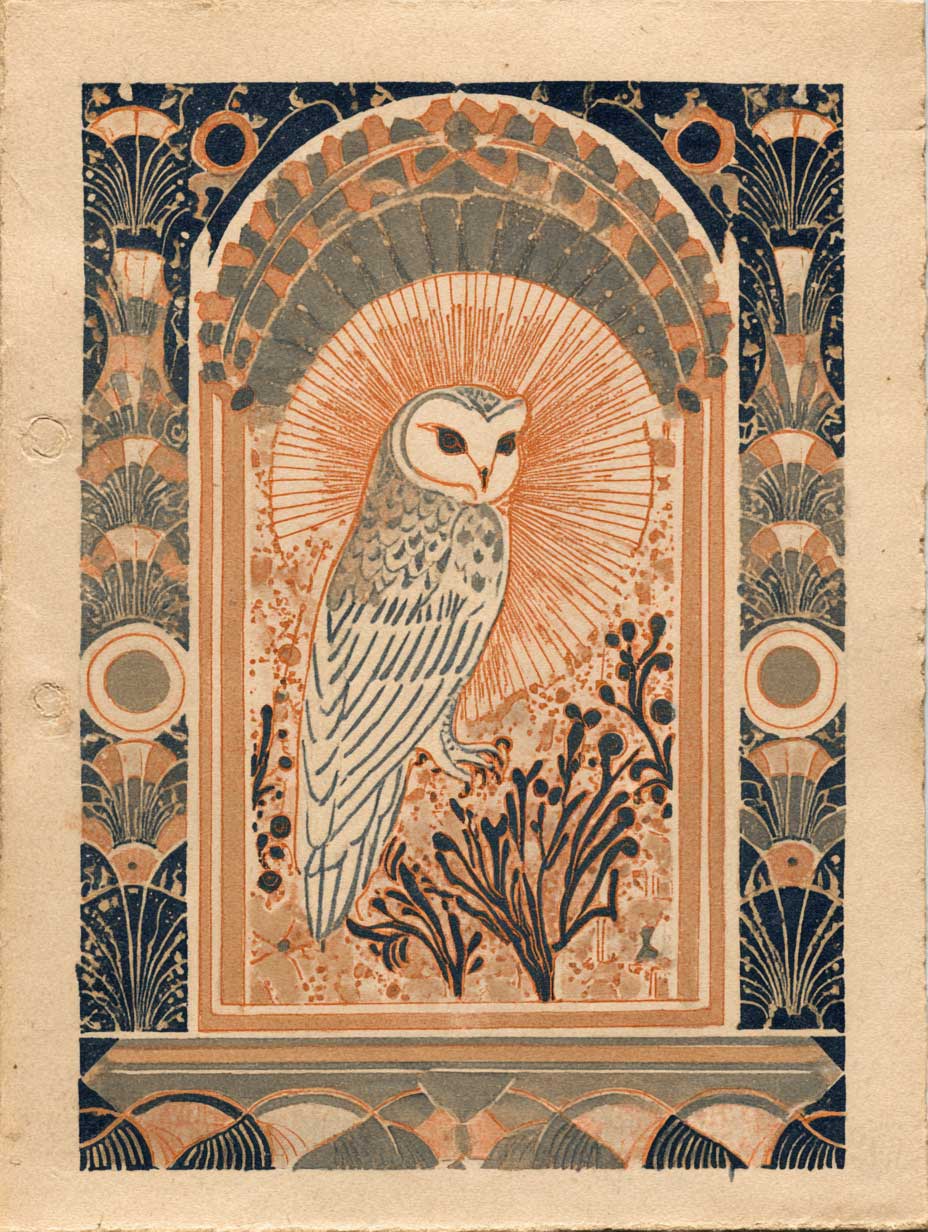
In this this lesson from our class Portrait and Pattern, artist Ce Duff invites you to explore the joy of watercolor pattern-making.
With a simple palette, you’ll experiment with both controlled brushwork and intuitive, abstract strokes to fill a page with unique designs. One of these playful patterns can then be used as the fill for your portrait, adding a personal and expressive touch to your artwork.
You can also listen to this month’s issue of the Studioworks journal. I find I love listening to books, podcasts and music while I draw, paint or go on a long walk. Enjoy.
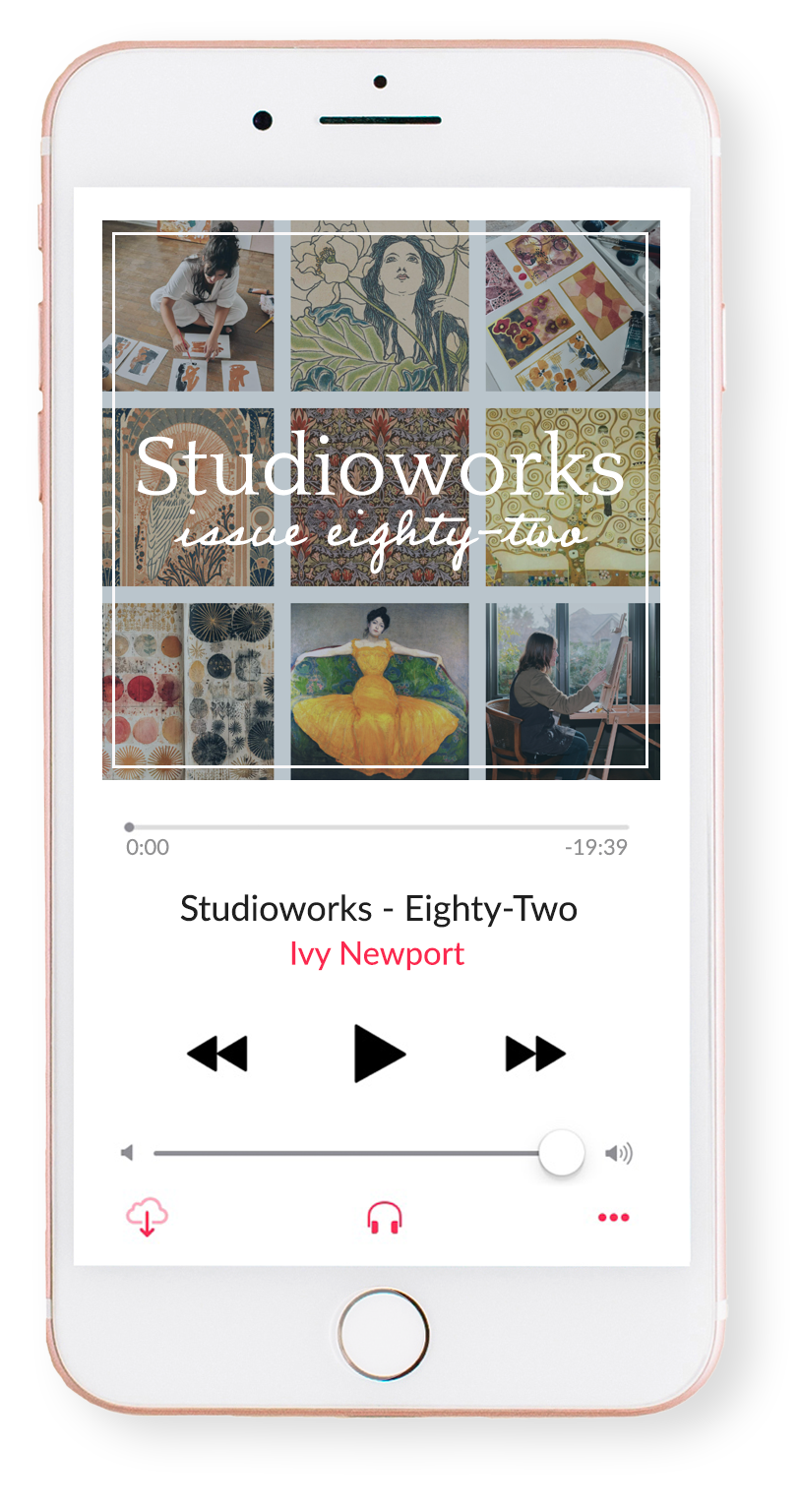

One of my favorite things to do is to curate inspiration. From Pinterest boards to books, resources, playlists and more - I love to share anything that might facilitate learning, expansion, and sparks of curiosity! Being an artist, we naturally crave these things so here are some of this month’s picks from me to you.
I had so much fun curating this list. I hope you enjoy!!
Classes that pair well with this month’s theme in your Studioworks Creative Library